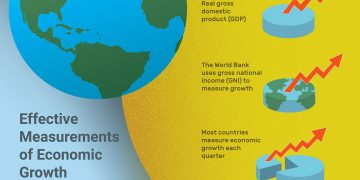Introduction
Wall Street, often seen as the barometer for the global financial markets, is an essential space where key economic, corporate, and geopolitical trends intersect. The movements on Wall Street are not just reflective of short-term investor sentiment but also predictive of more profound and longer-lasting market changes. Recent fluctuations, driven by economic data, Federal Reserve policies, and external geopolitical tensions, have sparked considerable speculation about the future direction of the market.
This article examines the recent trends in Wall Street and explores what these movements may signify for future market shifts. By analyzing the impact of rising inflation, interest rate hikes, sector rotations, and market volatility, we will explore how these factors can signal impending changes in broader financial markets.
Section 1: Impact of Inflation and Interest Rate Hikes
1.1 The Rising Tide of Inflation
Inflation has been a central theme in recent market movements on Wall Street. As consumer prices climb, the cost of living increases, affecting everything from consumer sentiment to corporate profitability. The impact of inflation on the market is multifaceted, often influencing investor behavior in several ways.
- Sector Impact: Certain sectors are more susceptible to inflationary pressures. For instance, the technology sector, which often relies on cheap borrowing to fund its growth, tends to suffer when interest rates rise. Growth stocks in particular, especially those in the tech sector, have seen significant declines as the market prices in the effect of rising rates on their future earnings.
- Commodity Rally: On the other hand, inflation tends to benefit commodity-based assets. Energy stocks, particularly those in oil and gas, have seen price surges, as high inflation often leads to increased demand for commodities. Investors may flock to safe-haven assets like gold and silver when inflation remains stubbornly high.
- Impact on Consumer Spending: Higher inflation, particularly in essentials like food, energy, and housing, can reduce consumers’ discretionary spending. Wall Street is closely watching consumer sentiment data, and there is growing concern that prolonged inflation could lead to a contraction in consumer spending, which could eventually harm retail and luxury goods sectors.
1.2 Federal Reserve’s Aggressive Rate Hikes
In response to inflation, the Federal Reserve has significantly raised interest rates in recent months. These rate hikes, designed to curb inflation, have played a pivotal role in shaping market dynamics.
- Stock Market Declines: Interest rate hikes directly impact equity markets. As borrowing costs increase, companies—particularly those with high debt loads or those reliant on low-cost financing—become less profitable. The stock market, particularly growth stocks, reacts by pulling back, as rising rates erode the present value of future cash flows.
- Bond Market Volatility: Rising interest rates have led to increased volatility in the bond market, as the yields on government bonds climb. Higher rates make existing bonds with lower yields less attractive, leading to declines in bond prices.
- Shift in Investor Sentiment: The Fed’s decision to raise rates signals a more cautious approach to economic expansion. Wall Street’s reaction has often been characterized by an initial sell-off in riskier assets and a shift towards safer investments. However, investors are also closely monitoring any signs of the Fed easing its rate hikes if inflation shows signs of abating.
Section 2: Market Rotation and Sector Shifts
2.1 Rotation from Growth to Value Stocks
In recent months, there has been a notable rotation from growth stocks to value stocks on Wall Street. This shift is a direct consequence of rising interest rates and inflationary concerns, which tend to hit high-growth sectors hardest.
- Growth Stocks Under Pressure: As mentioned earlier, growth stocks—especially those in technology—suffer during periods of high inflation and rising interest rates. Many of these stocks are priced for future earnings growth, and as rates climb, their valuations decline. High-growth sectors, including tech, biotech, and consumer discretionary, have experienced significant sell-offs.
- Value Stocks Gain Favor: Conversely, value stocks, which are typically more established companies with stable earnings, have outperformed during this rotation. Sectors such as energy, utilities, and consumer staples, which offer more predictable cash flows, have been favored by investors looking for stability amid rising inflation. These stocks are often seen as safer bets when the economy faces uncertainty.
- Defensive Sectors Attract Investment: Defensive sectors, like healthcare and utilities, are increasingly attractive in a high-inflation environment. These industries tend to be less sensitive to economic cycles and more insulated from inflationary pressures. As a result, Wall Street investors have begun allocating more funds to these areas, expecting them to perform well even if economic growth slows.
2.2 Technology Sector Struggles
The technology sector, which has historically been a leader in market rallies, has recently faced significant challenges. The combination of higher interest rates and inflation has negatively impacted the tech-heavy NASDAQ, which has seen considerable declines.
- Valuation Adjustments: With rising rates, high-flying technology stocks, which have often been valued based on future growth, are seeing a valuation correction. Many of these stocks are now considered overpriced, and the market has begun recalibrating their valuations.
- Shift Toward Profitable Tech Firms: There has been a shift within the technology sector itself, with investors increasingly focusing on firms that are not only growing but are also generating consistent profits. Startups with heavy cash burn are under pressure, while larger tech firms that demonstrate strong cash flow generation have managed to weather the storm more effectively.
- Market Sentiment on Innovation: While growth has slowed in some areas, innovation in fields like artificial intelligence, cloud computing, and cybersecurity continues to capture investor attention. However, only firms with strong fundamentals are likely to benefit in the short term, as investors become more discerning about long-term risk.
2.3 Potential Impact on Real Estate
The real estate market, another closely monitored sector, has also been impacted by Wall Street’s response to interest rate hikes.
- Housing Market Slowdown: Higher interest rates mean higher mortgage rates, which can lead to a slowdown in the housing market. Wall Street is already seeing the effects of this slowdown in the performance of real estate investment trusts (REITs) and homebuilder stocks. The higher cost of borrowing dampens consumer demand for homes, which could lead to declines in housing prices.
- Commercial Real Estate in Flux: Commercial real estate has faced additional challenges in the wake of the pandemic, with many businesses adopting hybrid or remote work arrangements. The shifting demand for office space could affect commercial real estate valuations, and Wall Street is paying close attention to this trend, with mixed outlooks for urban and suburban commercial properties.

Section 3: Geopolitical Factors and Global Risks
3.1 The Russia-Ukraine Conflict and Market Volatility
The ongoing Russia-Ukraine conflict has been a significant factor in recent Wall Street movements. Geopolitical instability tends to drive market volatility, particularly in sectors like energy and defense.
- Energy Price Fluctuations: The war in Ukraine has disrupted global energy supply chains, leading to sharp increases in energy prices. Wall Street has closely followed these developments, with oil and gas stocks benefitting from higher prices. However, investors are also wary of the longer-term consequences of sustained geopolitical tensions, especially concerning energy supply chains.
- Risk Aversion: Geopolitical instability often leads to risk aversion in the market. Wall Street investors are quick to adjust their portfolios in response to the uncertainty caused by the conflict, with many moving assets into safer investments like U.S. Treasury bonds and precious metals.
3.2 Supply Chain Disruptions
Ongoing supply chain disruptions, exacerbated by the pandemic and geopolitical conflicts, continue to affect global markets. Wall Street is increasingly focused on how supply chain bottlenecks are influencing inflation and the broader economy.
- Impact on Profit Margins: Many companies are seeing increased costs due to supply chain issues, which are cutting into profit margins. Investors are looking for companies that can either absorb these costs or pass them onto consumers without losing market share.
- Focus on Manufacturing and Logistics: Companies involved in logistics and manufacturing are seeing increased demand due to the disruptions. Wall Street is closely watching these sectors, as companies that can navigate supply chain challenges effectively are expected to see increased profitability.
Section 4: Conclusion
Recent movements on Wall Street signal a period of significant change for the markets. Inflationary pressures, rising interest rates, and sector rotations have led to recalibrations in investor strategies, with a shift from high-growth stocks to value and defensive sectors. Technology stocks, in particular, have faced a considerable downturn, while sectors like energy, consumer staples, and utilities have attracted increasing attention.
Geopolitical risks, such as the Russia-Ukraine conflict, continue to add uncertainty, particularly in the energy market. The ongoing supply chain disruptions also affect many sectors, forcing investors to adapt their strategies to the changing market dynamics.
For investors, understanding these shifts is crucial. While volatility is expected to persist, opportunities exist in sectors that can navigate these challenges. As Wall Street adapts to the evolving economic landscape, careful analysis of market trends and investor sentiment will be essential for success in the coming months.



































